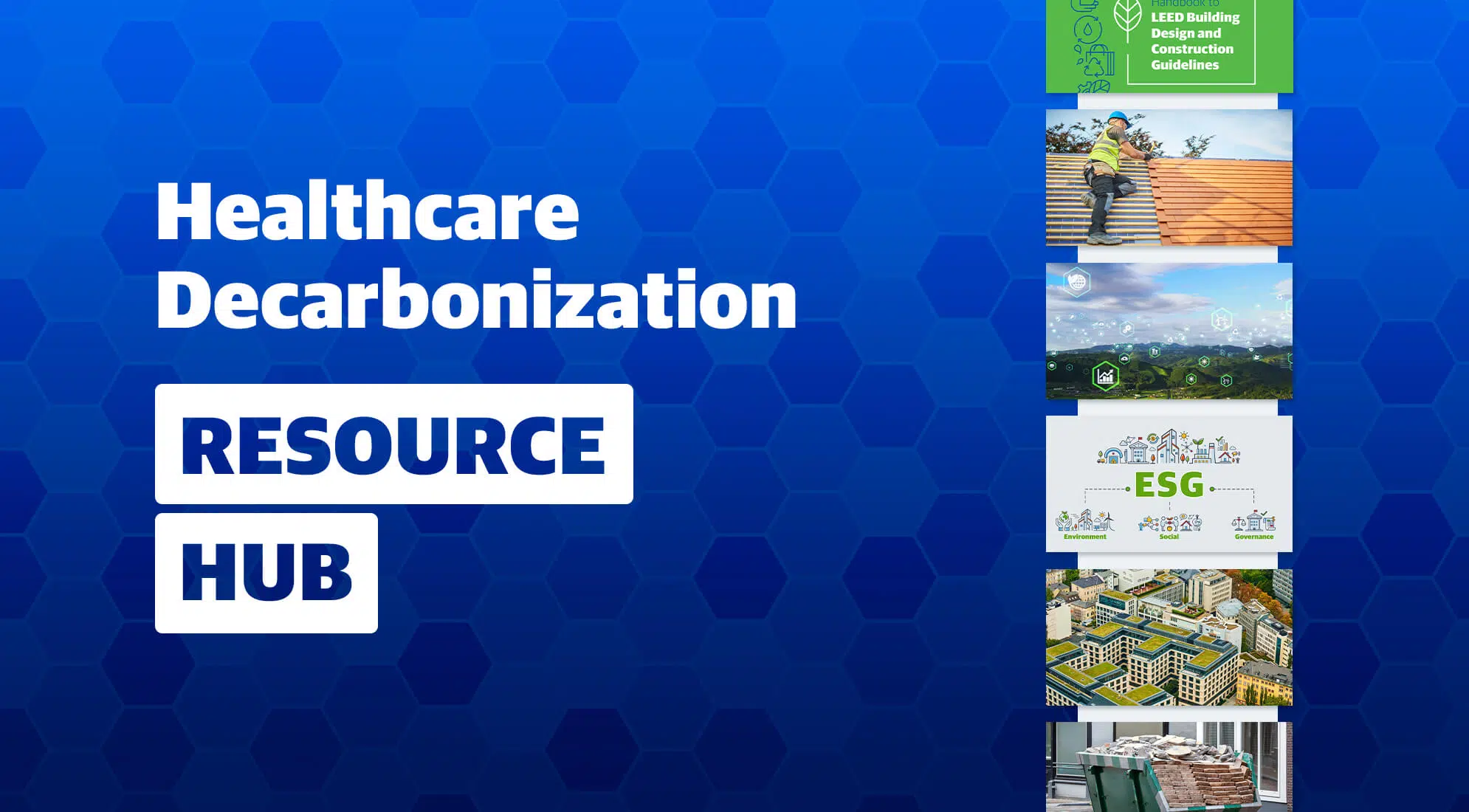Hospitals and health systems, prompted by internal goals and a call to action from the federal government, are working to reduce carbon emissions by 50% by 2030. That’s a lofty goal, and one reason that decarbonization is the talk of the industry.
We recently held a lunch and learn event in partnership with the American Society of Health Care Engineering (ASHE) to bring together two industry leaders to discuss decarbonizing hospitals. Among other topics, they discussed the challenges healthcare facilities leaders are facing as they implement sustainability measures.
Keeping Up With Regulations
There is a sense that, when it comes to decarbonizing hospitals, industry leaders are forced to build the car as it drives it down the highway. While the federal government has written a pledge to mobilize the industry to reduce emissions, nearly all of the details of making good on that pledge are yet to be determined.
As regulatory codes are developed and the details of requirements are ironed out, hospital leaders may find themselves struggling to keep up with evolving obligations, whether they be technological or operational. Leaders will have to keep their ears to the ground and their eyes on regulatory agencies to ensure they are meeting the most recent standards.
Educating Executives
As with any major hospital facilities initiative, the c-suite must be on board for a decarbonization program to take off and succeed. Getting their support will require facilities leaders to educate hospital executives about reducing carbon footprint and to present data that demonstrates the social and fiscal impact of sustainability measures.
As Charles Clay, Director of Support and Ancillary Services at Sutter Health eloquently put it, “It’s not just the financial impact. We’re focused on reducing healthcare costs, but we’re also focused on doing something good for the environment because that environment is where our patients live.”
Executives may be swayed, for instance, by seeing the impact of reduced energy use on the bottom line or how using alternative energy sources like solar or wind power will improve air quality in the community. Luckily, there are data and technology sources that can help. ENERGY STAR offers a product for benchmarking buildings. A facilities condition assessment, or FCA, can also tell executives a clear story about energy efficiency.
To borrow a phrase from lunch and learn speaker Richie Stever, Vice President of Real Estate and Property Management at the University of Maryland Medical System, facility leaders have to give the c-suite a reason to do the right thing.
Inspiring Behavioral Change
If any hospital sustainability program is going to work, facilities leaders will need help not only from the top down, but from the ground up. This is easier said than done. As Stever pointed out during the lunch and learn event, people treat their workplaces differently than they treat their homes.
“How many times do you see people walk out of a single stall bathroom and leave the light on. They don’t leave that light on at home, but they do it at work. We have to re-adjust the way people think,” Stever said.
Inspiring people to behave in ways that are more friendly to the environment is an uphill battle. Old habits die hard. But if hospitals are going to hit their emissions goals, they are going to need everyone to pitch in.
The Uniqueness of the Healthcare Environment
Hospitals are under constant strain. They are open 24 hours a day, seven days a week – there is no downtime. The power must run around the clock. The HVAC must operate at all times. Doctors and nurses must have the ability to deliver critical care at a moment’s notice or lives will be lost. The stakes don’t get higher than that.
On a more routine level, a hospital is a place where patients live. It’s a place where they receive visitors and eat meals. At any given time, a hospital is home to hundreds of people.
It is fair to wonder if green energy producers can support a facility as demanding as a hospital. During the lunch and learn event, Gordian’s Director of Market Strategy and Development for Healthcare, Mark Kenneday, a man with close to four decades of experience in the healthcare industry, wondered aloud if a kitchen lacking gas-fired equipment prepare tens of thousands of meals every single day.
These are the sorts of practical, nuts-and-bolts challenges to decarbonization and sustainability efforts in hospitals and healthcare facilities. To meet these challenges, hospital systems are adding energy managers to their staffs, and in some cases, taking the extraordinary step of building LEED Gold certified facilities.
The Existing Facilities Backlog
Between the COVID-19 pandemic and supply chain bottlenecks, the last few years have been unkind to facilities in every industry. Hospitals were hit the hardest. Not only were clinicians overworked and under siege by a wave of patients suffering from a virus the world had never seen, but hospitals had to change their intake systems and other aspects of their operations on the fly. It was a stress test of grand proportions.
The pandemic is still exerting an influence on hospitals. Reacting to COVID-19 forced hospitals to put renovations and other construction projects on hold, creating a backlog of work yet to be finished. Making the necessary facilities alterations to reduce carbon emissions at the expense of addressing the current backlog will only put hospitals at further risk.
In an effort to tackle existing backlogs, hospitals and healthcare facilities are turning to alternative means of construction project delivery. Gordian’s Job Order Contracting (JOC), helps repair, replacement and simple construction begin faster by enabling many projects to be completed through one competitively-awarded contract. Proven to reduce procurement time by 25% compared to other project delivery methods, JOC is ideal for tackling a backlog of projects.
Decarbonizing Hospitals: A Paradigm Shift
This is hardly an exhaustive list of the difficulties inherent in decarbonizing hospitals. Reducing carbon footprint is an immense challenge that will require operational and technological changes, significant financial investments and an altering of long-term plans. This will be a holistic effort.
However, the long-term prospects are not all gloomy. In the next blog post in our special series on decarbonization, we’ll look at the opportunities going green offers healthcare facilities.






